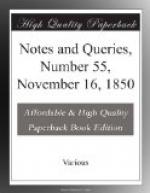“Est autem crux illa longitudinem habens palmae de auro purissimo mirabili opere fabricats, quae in modum techae clauditur et aperitur. Cernitur in ea quaedarn Dominicae crucis portio, (sicut saepe multorum miraculorum argumento probatum est). Salvatoris nostri ymaginem habens de ebore densissime sculptam et aureis distinctionibus mirabiliter decoratam.”
St. Margaret appears to have destined it for the abbey which she and her royal husband, Malcolm III., founded at Dunfermline in honour of the Holy Trinity: and this cross seems to have engaged her last thoughts for her confessor relates that, when dying, she caused it to be brought to her, and that she embraced, and gazed steadfastly upon it, until her soul passed from time to eternity. Upon her death (16th Nov., 1093), the Black Rood was deposited upon the altar of Dunfermline Abbey, where St. Margaret was interred.
The next mention of it that I have been enabled to make note of, occurs in 1292, in the Catalogue of Scottish Muniments which were received within the Castle of Edinburgh, in the presence of the Abbots of Dunfermline and Holy Rood, and the Commissioners of Edward I., on the 23rd August in that year, and were conveyed to Berwick-upon-Tweed. Under the head
“Omnia ista inventa
fuerunt in quadam cista in Dormitorio S. Crucis, et
ibidem reposita praedictos
Abbates et altos, sub ecrum sigillis.”
we find
“Unum scrinium argenteum
deauratum, in quo reponitur crux quo vocatur
la blake rode.”—Robertson’s
Index, Introd. xiii.
It does not appear that any such fatality was ascribed to this relique as that which the Scots attributed to the possession of the famous stone on which their kings were crowned, or it might be conjectured that when Edward I. brought “the fatal seat” from Scone to Westminster, he brought the Black Rood of Scotland too. That amiable and pleasing historian, Miss Strickland, has stated that the English viewed the possession of this relique by the Scottish kings with jealousy; that it was seized upon by Edward I., but restored on the treaty of peace in 1327. This statement is erroneous; the rood having been mistaken for the stone, which, by the way, as your readers know, was never restored.
We next find it in the possession of King David Bruce, who lost this treasured relique, with his own liberty, at the battle of Durham (18th Oct., 1346), and from that time the monks of Durham became its possessors. In the Description of the Ancient Monuments, Rites, and Customs of the Abbey Church of Durham, as they existed at the dissolution, which was written in 1593, and was published by Davies in 1672, and subsequently by the Surtees Society, we find it described as




